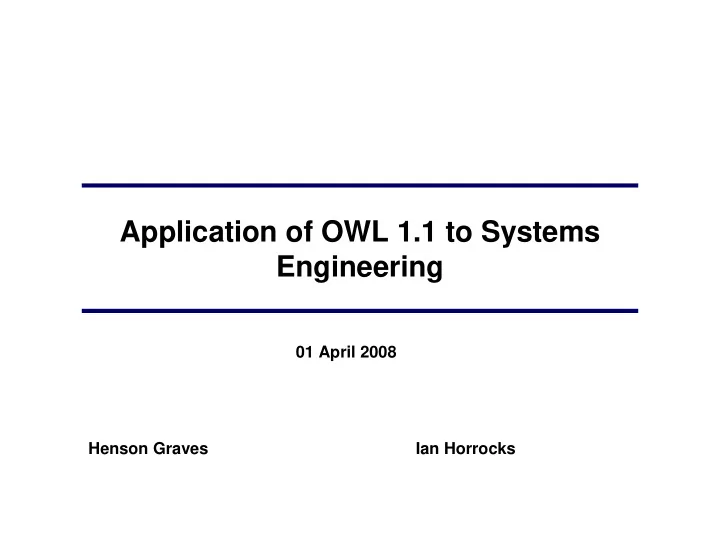

Application of OWL 1.1 to Systems Engineering 01 April 2008 Henson Graves Ian Horrocks
Use of Knowledge Representation and Reasoning in Product Development Current Systems Engineering languages, standards, and � tools are Restricted in (certain aspects of) their expressiveness and do not provide formal � semantics Yet many activities involve (some form of) reasoning, e.g., requirements � verification Long history of attempts to use formal methods for � engineering � Too hard to use, don’t scale Can OWL 1.1 provide a semantic integration framework? � For engineering domain, with ontology capturing meaning independent of � interpretation by subject matter experts? So automated reasoning can be used to check design properties such as � consistency and conformance with specification? Not to replace SysML, UML, and engineering tools, but incorporate them � into an integrated framework 2
We Are Developing an Air System Ontology in Protégé 4.0 Using the Fact++ Reasoner and DOLCE Ultra Lite (DUL) …use of a foundation ontology saves a lot of time 3
Achievements � Used class constructors to define (requirements) classes of physical objects with structural and measurable properties � Resulting ontology has about 300 classes � Verified that requirements class is consistent � Defined (design) classes characterized by generic instances � Gone outside the logic to database that represents results of measurement analysis & simulation to conclude additional properties of design instance � Verified that resulting extended generic design instance still satisfies requirements 4
Benefits and Shortcomings of OWL 1.1 � OWL 1.1 with DUL classes works well for representation of product structure and (static) properties Used partOf relations, Quality , with values in Region � � New OWL 1.1 features crucial Complex role inclusions � — Transfer of properties across part-whole relations Extended support for datatypes � — Numerous design constraints relate to concrete values such as weight, speed, temperature, distance, … — Complex datatypes, representing, e.g., shapes or performance measures Extended annotation � — E.g., for provenance of information 5
Benefits and Shortcomings of OWL 1.1 � Some requirements not (easily) expressible OWL DL � Extended reasoning with datatypes and values, e.g., agregation — Weight of product is sum of weights of components � Behavioral and other dynamic requirements — I.e., statements involving state change � Interfacing and integrating with other systems — Storage and representation systems such as DBs — Testing and measurement systems such as simulators 6
Lessons Learned � OWL 1.1 is not a replacement for systems engineering language and tools But is a good candidate for semantic integration � � Potential for reasoning in OWL for systems engineering is great Achieved reasoning experiments for requirements consistency, and design � satisfaction of requirements � Further language and tool development is needed Ontology management � Explanation and annotation � Modularization � Architecture to integrate with other computational and reasoning systems � 7
Recommend
More recommend